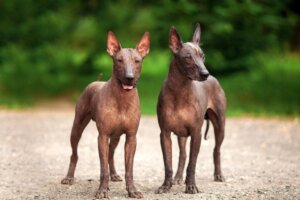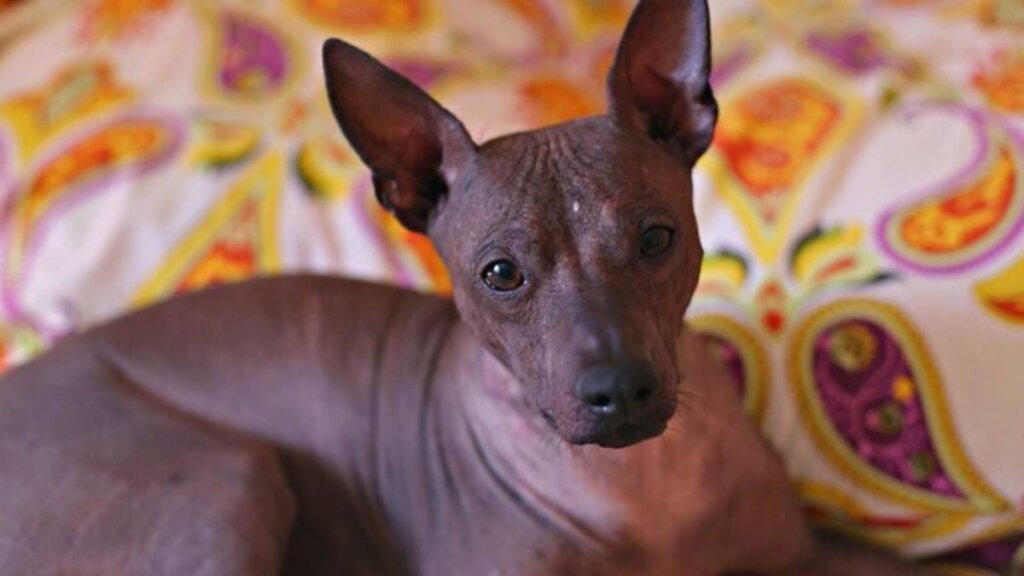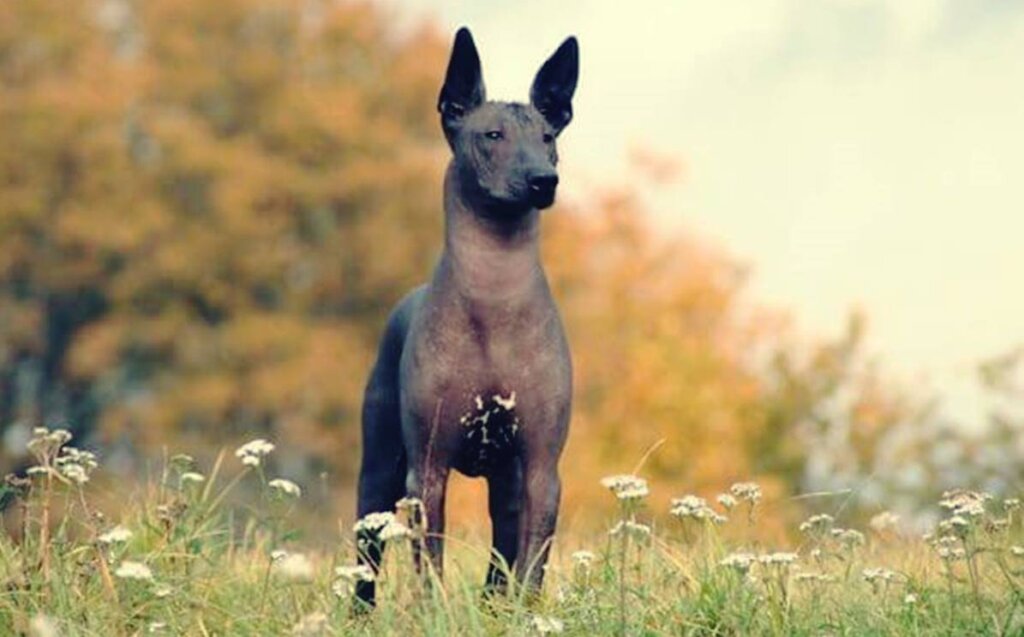Xoloitzcuintle: The Aztec Dog Who Guided Souls to the Underworld


Written and verified by the psychologist Valeria Sabater
If you’ve seen the Disney movie, Coco, you’ll no doubt remember the rather odd pet that accompanied the main character, Miguel. It was hairless, black, and somewhat strange-looking – a Xoloitzcuintle or Aztec dog. It should be noted that this isn’t just any breed of dog. In fact, it’s endemic to Mexico and has its origins in pre-Hispanic times.
This fascinating creature, domesticated more than 5,500 years ago, is one of the closest living relatives to the canines of antiquity. Indeed, its image instantly takes us back to another era, to a time deeply rooted in Mexican culture.
It’s said that when Europeans arrived in the Americas in the 16th century, they mistook Xolo dogs for dwarf horses. They also drove them to the point of extinction as they used them for food. Fortunately, a large group was able to take refuge in the mountains of Oaxaca and Guerrero, where they survive to the present day.
These animals are intelligent, faithful, and exceptional life companions. In fact, their companionship was even thought to extend beyond death, as the Aztecs thought they were in charge of guiding souls to the afterlife.
The Aztecs loved their Xolo dogs. They even wrapped them in blankets at night to protect them from the cold.

The fascinating history of the Xoloitzcuintle or Aztec dog
The first written document regarding the Xoloitzcuintle dates back to the 16th century. In it, Christopher Columbus described a breed of hairless dogs that lived with the Aztecs. He was struck by how the people cared for and appreciated this animal. They slept with them, tucked them in like children, and they were even buried with their owners.
It was soon discovered that the ancient Mayans revered these dogs because they were a representation of their god Xolotl. This deity was one of the most powerful and unique within their culture. He symbolized fire and lightning and was also the guide of the souls of the dead. However, he also had a dark side: he was the lord of monsters, misfortunes, and deformities.
Sadly, the European conquerors took a dim view of these spiritual practices and ideas. They started eating the meat from Xolo dogs, not to mention crossing them with European dogs, all practices that contributed to the weakening of this exceptional breed. At the beginning of the 19th century, the last Xoloitzcuintle dogs were found in small groups in mountainous areas.
The Xolotl or Aztec dog is a symbol of Mexican culture par excellence.
Xoloitzcuintle, a companion in life and death
Archaeologists have made numerous finds regarding what life was like for these really special dogs. Their skeletons, collars, bowls, and other belongings that the Aztecs made for these animals are preserved. There are numerous ceramics in their tombs that represented the duality contained in the deity Xólotl.
On the one hand, the veil of darkness, of the mysterious, of death, and that associated with the afterlife stood out. On the other hand, Xolotl was also the twin brother of the god Quetzalcóatl, the feathered serpent, who symbolized light, life, and wisdom. Such was the veneration toward this animal that it was assumed that whoever was cruel to this dog wouldn’t reach the afterlife after their death.

The Aztec dog today
It wasn’t until 1950 that the Xoloitzcuintle dog breed started to be noticed again in its homeland. In fact, numerous artists recovered images of this animal and started to represent it on canvas, in poems, books, and other cultural manifestations. The dog was part of their identity and they needed to bring it back from the past to the present.
A team of scientists traveled through Mexico in search of the last Xolos, recovering ten specimens. It was then that the revival of the breed began. They tried to make the breed as pure as possible, taking into account that its DNA is the oldest in existence in terms of dogs. This process was successful and today we can admire these exceptional animals, live with them, and enjoy their personalities.
What are Xolo dogs like?
Xolo dogs are highly valued, both for their unique history and their character. They’re extremely loyal, and calm but are also territorial since they’re extremely protective of their own. Just as they were in the past with the Aztec people.
- Their sociability and affection stand out. They build really strong bonds with their human families.
- In addition to the absence of hair, another distinguishing feature of their breed is the absence of premolars. Therefore, it’s necessary to protect their skin, keep them warm in winter, and hydrate their skin with protective sun creams in summer.
- They live for a long time and have a certain tendency to become overweight.
- Another prototypical genetic trait of these dogs is the early loss of their teeth. For this reason, their diet should be adapted.
There’s something really special about this breed of dog. They’re living vestiges of another time, animals that represented gods on earth that were on the point of extinction. These beautiful symbols of a Mexico gone by need to be loved and cared for.
If you’ve seen the Disney movie, Coco, you’ll no doubt remember the rather odd pet that accompanied the main character, Miguel. It was hairless, black, and somewhat strange-looking – a Xoloitzcuintle or Aztec dog. It should be noted that this isn’t just any breed of dog. In fact, it’s endemic to Mexico and has its origins in pre-Hispanic times.
This fascinating creature, domesticated more than 5,500 years ago, is one of the closest living relatives to the canines of antiquity. Indeed, its image instantly takes us back to another era, to a time deeply rooted in Mexican culture.
It’s said that when Europeans arrived in the Americas in the 16th century, they mistook Xolo dogs for dwarf horses. They also drove them to the point of extinction as they used them for food. Fortunately, a large group was able to take refuge in the mountains of Oaxaca and Guerrero, where they survive to the present day.
These animals are intelligent, faithful, and exceptional life companions. In fact, their companionship was even thought to extend beyond death, as the Aztecs thought they were in charge of guiding souls to the afterlife.
The Aztecs loved their Xolo dogs. They even wrapped them in blankets at night to protect them from the cold.

The fascinating history of the Xoloitzcuintle or Aztec dog
The first written document regarding the Xoloitzcuintle dates back to the 16th century. In it, Christopher Columbus described a breed of hairless dogs that lived with the Aztecs. He was struck by how the people cared for and appreciated this animal. They slept with them, tucked them in like children, and they were even buried with their owners.
It was soon discovered that the ancient Mayans revered these dogs because they were a representation of their god Xolotl. This deity was one of the most powerful and unique within their culture. He symbolized fire and lightning and was also the guide of the souls of the dead. However, he also had a dark side: he was the lord of monsters, misfortunes, and deformities.
Sadly, the European conquerors took a dim view of these spiritual practices and ideas. They started eating the meat from Xolo dogs, not to mention crossing them with European dogs, all practices that contributed to the weakening of this exceptional breed. At the beginning of the 19th century, the last Xoloitzcuintle dogs were found in small groups in mountainous areas.
The Xolotl or Aztec dog is a symbol of Mexican culture par excellence.
Xoloitzcuintle, a companion in life and death
Archaeologists have made numerous finds regarding what life was like for these really special dogs. Their skeletons, collars, bowls, and other belongings that the Aztecs made for these animals are preserved. There are numerous ceramics in their tombs that represented the duality contained in the deity Xólotl.
On the one hand, the veil of darkness, of the mysterious, of death, and that associated with the afterlife stood out. On the other hand, Xolotl was also the twin brother of the god Quetzalcóatl, the feathered serpent, who symbolized light, life, and wisdom. Such was the veneration toward this animal that it was assumed that whoever was cruel to this dog wouldn’t reach the afterlife after their death.

The Aztec dog today
It wasn’t until 1950 that the Xoloitzcuintle dog breed started to be noticed again in its homeland. In fact, numerous artists recovered images of this animal and started to represent it on canvas, in poems, books, and other cultural manifestations. The dog was part of their identity and they needed to bring it back from the past to the present.
A team of scientists traveled through Mexico in search of the last Xolos, recovering ten specimens. It was then that the revival of the breed began. They tried to make the breed as pure as possible, taking into account that its DNA is the oldest in existence in terms of dogs. This process was successful and today we can admire these exceptional animals, live with them, and enjoy their personalities.
What are Xolo dogs like?
Xolo dogs are highly valued, both for their unique history and their character. They’re extremely loyal, and calm but are also territorial since they’re extremely protective of their own. Just as they were in the past with the Aztec people.
- Their sociability and affection stand out. They build really strong bonds with their human families.
- In addition to the absence of hair, another distinguishing feature of their breed is the absence of premolars. Therefore, it’s necessary to protect their skin, keep them warm in winter, and hydrate their skin with protective sun creams in summer.
- They live for a long time and have a certain tendency to become overweight.
- Another prototypical genetic trait of these dogs is the early loss of their teeth. For this reason, their diet should be adapted.
There’s something really special about this breed of dog. They’re living vestiges of another time, animals that represented gods on earth that were on the point of extinction. These beautiful symbols of a Mexico gone by need to be loved and cared for.
This text is provided for informational purposes only and does not replace consultation with a professional. If in doubt, consult your specialist.







